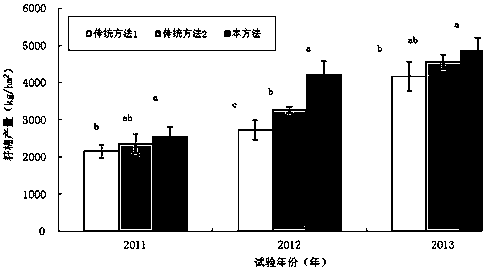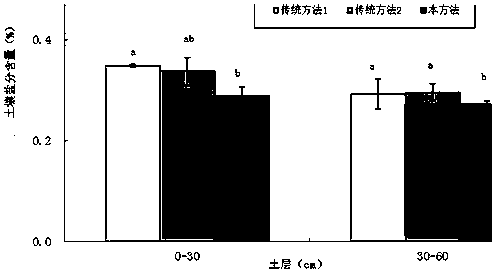Methods of Improving Cotton Yield and Planting Benefit in Heavy Saline Alkaline Land
A saline-alkali land and cotton technology, applied in the field of increasing cotton production and planting benefits in heavy saline-alkali land, can solve the problems of production decline, intensified water evaporation, resource waste, etc., and achieve the effects of synergistic symbiotic growth, reduced fertilizer loss, and increased cotton production
- Summary
- Abstract
- Description
- Claims
- Application Information
AI Technical Summary
Problems solved by technology
Method used
Image
Examples
Embodiment 1
[0026] Example 1: When the temperature in the winter of the previous year before cotton planting was stable at -5°C, the local underground salt water was extracted, and the surface was flooded with flood irrigation, and the irrigation volume was 150mm; the plastic film was covered in the early spring of March; fertilization was applied from late April to early May , the amount of fertilizer applied per hectare of land is equivalent to 90kg of pure N, P 2 o 5 The amount is 42kg, K 2 The amount of O is 30kg, and the type of fertilizer is a loss-controlling fertilizer mixed with attapulgite. Cotton is sown immediately after fertilization, the sowing row spacing is 60cm; the plant spacing is 28cm; after the cotton seedlings emerge, the seedlings are fixed and replenished in time, and the number of plants per mu is 45,000 plants / hm 2 ; During the period of 3 leaves of cotton seedlings in early June, soybeans were intercropped between cotton rows and on-demand on film, and the int...
Embodiment 2
[0027] Example 2: When the temperature in the winter of the previous year before cotton sowing was stable at -5°C, the local underground salt water was extracted, and the surface was flooded with water, and the irrigation volume was 180mm; the plastic film was covered in the early spring of March; fertilization was applied from late April to early May , the amount of fertilizer applied per hectare of land is equivalent to 100kg of pure N, P 2 o 5 The amount is 45kg, K 2 The amount of O is 35kg, and the type of fertilizer is a loss-controlling fertilizer mixed with attapulgite. Cotton is sown immediately after fertilization, the sowing row spacing is 60cm; the plant spacing is 29cm; after the emergence of cotton seedlings, the seedlings are fixed and replenished in time, and the number of plants per mu is 53,000 plants / hm 2 ; During the period of 3 leaves of cotton seedlings in early June, soybeans were intercropped between cotton rows, and on-demand sowing was adopted on fil...
Embodiment 3
[0028]Example 3: When the temperature of the previous winter before cotton planting was stable at -5°C, the local underground salt water was extracted, and the surface was flooded with water, and the irrigation volume was 160mm; the plastic film was covered in the early spring of March; fertilization was applied from late April to early May , the amount of fertilizer applied per hectare of land is equivalent to 95kg of pure N, P 2 o 5 The amount is 43.5kg, K 2 The amount of O is 33kg, and the fertilizer type is selected as a loss-controlling fertilizer mixed with attapulgite; cotton is sown after fertilization, and the sowing row spacing is 60cm; 2 ; During the period of 3 leaves of cotton seedlings in early June, soybeans were intercropped between cotton rows, and on-demand sowing was adopted on film, and the intercropping method was 1:1. One row of soybeans was intercropped between cotton rows, forming a pattern of one row of cotton and one row of soybeans. The plant spaci...
PUM
 Login to View More
Login to View More Abstract
Description
Claims
Application Information
 Login to View More
Login to View More - R&D
- Intellectual Property
- Life Sciences
- Materials
- Tech Scout
- Unparalleled Data Quality
- Higher Quality Content
- 60% Fewer Hallucinations
Browse by: Latest US Patents, China's latest patents, Technical Efficacy Thesaurus, Application Domain, Technology Topic, Popular Technical Reports.
© 2025 PatSnap. All rights reserved.Legal|Privacy policy|Modern Slavery Act Transparency Statement|Sitemap|About US| Contact US: help@patsnap.com



